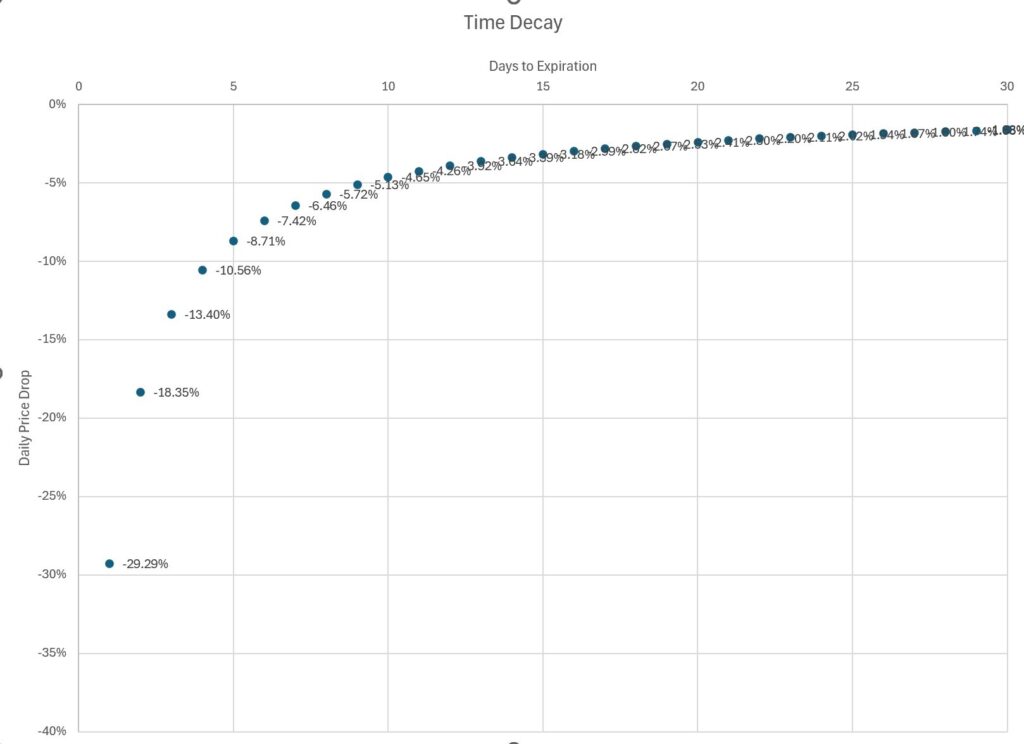Good morning, traders…
A hidden enemy lurks in the shadows cast by every trade you make.
Each day you hold an options position, it’s working against you.
Even if the stock moves in your favor, it’s eating away at your profits.
And if the stock trades sideways, it’s bleeding money while you wait.
I’m talking about time decay.
And it all starts with a classic tale…
A trader buys options with 30 days to expiration, thinking they have “plenty of time.” The stock moves in their direction in the first week, but they get greedy.
They don’t scale out. They hold it all for the grand slam. Two weeks pass. Three weeks. The stock is still up, but it’s not moving any higher — and the option value is bleeding out.
By expiration, they’ve given back all their gains — and then some.
Why does this happen? Because time decay doesn’t move in a straight line.
It accelerates exponentially as expiration approaches.
And if you don’t understand when that acceleration happens, you’re going to lose money on trades that should have been winners.
Don’t Let Time Destroy Your Trades.
How Time Decay Actually Works
Time decay (a.k.a. theta) measures how much value an option loses each day as it approaches expiration.
The closer you get to expiration, the faster that decay happens.
This chart shows you the daily price drop as an option approaches expiration:

At 30 days to expiration, you’re losing less than 1% per day. The option has time to work. The stock can move. You have breathing room.
At 15 days to expiration, time decay is around -5% per day. The curve is starting to steepen. You’re still manageable, but the clock is ticking louder.
At 10 days to expiration, decay accelerates to -8.71%. This is where things get dangerous. You’re losing almost 9% of your option’s value every single day, even if the stock doesn’t move against you.
At 5 days to expiration, you’re losing -13.40% per day. At 3 days, it’s -18.35%. And if you’re holding into expiration day (zero days to expiration), you lose -29.29% in a single session.
That’s the trap. Time decay accelerates exponentially in the final 10 days.
If you’re holding options into that window, you’re fighting an uphill battle every single day.
The Dangers of Nearing Expiration
There’s a certain point in a contract’s lifespan where time decay becomes your primary enemy.
You buy a call with 30 days to expiration. The stock moves up in the first week. You scale out some gains, but hold for more.
Each day you hold, time decay is stealing value.
By day 20, the stock is still higher, but your option value has barely moved.
By day 25, you’re break-even.
By three days to expiration, the remaining contracts have lost 90% of their value.
Time decay accelerates while the underlying stock’s move decelerates.
The solution? Take profits before the acceleration zone.
If you’re holding options with less than 10 days to expiration and the trade is winning — you really need to consider taking the win and moving on.
The Sweet Spot for Expiration Dates
What’s the sweet spot that balances time decay with enough runway for your trade to work?
I suggest swing trading options with 21-45 days to expiration.
Here’s why:
- You’re past the brutal acceleration zone. Time decay is manageable—around 1-3% per day. The option has time to breathe.
- You have enough runway for the stock to move. If your thesis is right but the timing is off by a few days, you’re not killed by theta.
- You can hold through minor pullbacks without panicking. Short-dated options force you to be right immediately. Longer-dated options give you flexibility.
The chart shows this clearly. With 15 days or more, the curve flattens out. You’re not fighting exponential decay anymore.
That said, I’ll still trade shorter-dated options (7-14 days) if the setup is strong and I’m planning to take profits quickly.
But I’m not holding those into the final 5 days unless I have a very specific reason.
How To Use Time Decay To Your Advantage
When you enter a trade, look at the “days to expiration” column.
If you’re buying options with less than 10 days left, you’re in the danger zone. You need to be right immediately — and you need to take gains fast.
If you’re holding a winning trade and you’re inside 10 days to expiration, the price action needs to outpace the time decay. Do you really think it can?
If you want to give your trades room to work, buy options with 21-45 days to expiration. You’ll pay slightly more in premium, but you’re buying the most valuable thing you can have in options trading – time.
Time decay is relentless. It doesn’t care if you’re up, down, or sideways.
It’s taking value every single day.
But it doesn’t have to ruin your next trade…
I’ve solved 99% of my time decay concerns by following the Smart Money.
I let them pick the expiration dates. No need to guess which contract will work best.
Want to see which contracts the Smart Money’s hammering this week?
Our Thursday “lotto sessions” with the great Ethan Harms are an absolute must-watch.
Last Thursday, he called out a 400% lotto winner on QuantumScape Corp. (NYSE: QS).*
Don’t miss the next 5x slam-dunk…*
Join us TOMORROW at 4 p.m. EST.
Happy trading,
Ben Sturgill
*Past performance does not indicate future results. Not typical


